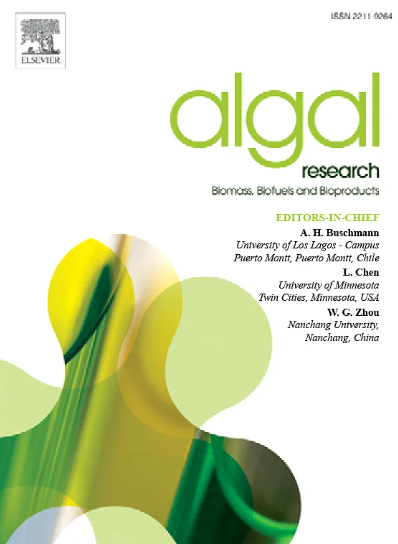In vitro anticancer properties of the red seaweed Laurencia (J.V. Lamouroux, 1813): A systematic review
IF 4.6
2区 生物学
Q1 BIOTECHNOLOGY & APPLIED MICROBIOLOGY
Algal Research-Biomass Biofuels and Bioproducts
Pub Date : 2025-05-09
DOI:10.1016/j.algal.2025.104089
引用次数: 0
Abstract
Laurencia comprises several species of seaweed that have been identified as valuable sources of bioactive substances with potential applications in the treatment of cancer. The aim of this paper is to provide an overview of in vitro research on the anticancer properties of species of Laurencia through a systematic review. An exploratory bibliographical review of articles published between the years 2000 and 2022 was conducted following the PRISMA protocol. The inclusion criteria were in vitro experimental studies, anticancer activity, and Laurencia. Forty-six articles that investigated the cytotoxic and anticancer activity of nonpolar and polar extracts, fractions, and compounds isolated from species of Laurencia were included. The constituents studied by the authors reaffirm the ability to inhibit the viability and proliferation of different neoplastic cell lines, control the cell cycle, and promote the induction of cell death pathways.
红海藻Laurencia的体外抗癌特性(J.V. Lamouroux, 1813):系统综述
Laurencia由几种海藻组成,这些海藻已被确定为生物活性物质的宝贵来源,在治疗癌症方面具有潜在的应用价值。本文通过系统的综述,综述了国内外有关劳伦西亚属植物抗癌特性的体外研究概况。根据PRISMA协议,对2000年至2022年间发表的文章进行了探索性书目审查。纳入标准为体外实验研究、抗癌活性和Laurencia。本文收录了46篇文章,研究了从月桂属植物中分离的非极性和极性提取物、馏分和化合物的细胞毒性和抗癌活性。作者研究的成分重申了抑制不同肿瘤细胞系的活力和增殖、控制细胞周期和促进诱导细胞死亡途径的能力。
本文章由计算机程序翻译,如有差异,请以英文原文为准。
求助全文
约1分钟内获得全文
求助全文
来源期刊

Algal Research-Biomass Biofuels and Bioproducts
BIOTECHNOLOGY & APPLIED MICROBIOLOGY-
CiteScore
9.40
自引率
7.80%
发文量
332
期刊介绍:
Algal Research is an international phycology journal covering all areas of emerging technologies in algae biology, biomass production, cultivation, harvesting, extraction, bioproducts, biorefinery, engineering, and econometrics. Algae is defined to include cyanobacteria, microalgae, and protists and symbionts of interest in biotechnology. The journal publishes original research and reviews for the following scope: algal biology, including but not exclusive to: phylogeny, biodiversity, molecular traits, metabolic regulation, and genetic engineering, algal cultivation, e.g. phototrophic systems, heterotrophic systems, and mixotrophic systems, algal harvesting and extraction systems, biotechnology to convert algal biomass and components into biofuels and bioproducts, e.g., nutraceuticals, pharmaceuticals, animal feed, plastics, etc. algal products and their economic assessment
 求助内容:
求助内容: 应助结果提醒方式:
应助结果提醒方式:


